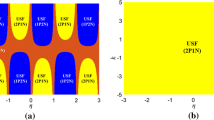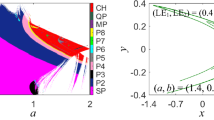Abstract
Initial-dependent extreme multi-stability and offset-boosted coexisting attractors have been significantly concerned recently. This paper constructs a novel five-dimensional (5-D) two-memristor-based dynamical system by introducing two memristors with cosine memductance into a three-dimensional (3-D) linear autonomous dissipative system. Through theoretical analyses and numerical plots, the memristor initial-boosted coexisting plane bifurcations are found and the memristor initial-dependent extreme multi-stability is revealed in such a two-memristor-based dynamical system with plane equilibrium. Furthermore, a dimensionality reduction model with the determined equilibrium is established via an integral transformation method, upon which the memristor initial-dependent extreme multi-stability is reconstituted theoretically and expounded numerically Finally, physically circuit-implemented PSIM (power simulation) simulations are carried out to validate the plane offset-boosted coexisting behaviors.
Similar content being viewed by others
References
Eshraghian K, Kavehei O, Cho K R, et al. Memristive device fundamentals and modeling: Applications to circuits and systems simulation. Proc IEEE, 2012, 100: 1991–2007
Li Q, Hu S, Tang S, et al. Hyperchaos and horseshoe in a 4D memristive system with a line of equilibria and its implementation. Int J Circ Theor Appl, 2014, 42: 1172–1188
Zhou L, Wang C, Zhou L. Generating four-wing hyperchaotic attractor and two-wing, three-wing, and four-wing chaotic attractors in 4D memristive system. Int J Bifurcation Chaos, 2017, 27: 1750027
Bao B, Jiang T, Wang G, et al. Two-memristor-based Chua’s hyperchaotic circuit with plane equilibrium and its extreme multi-stability. Nonlinear Dyn, 2017, 89: 1157–1171
Prousalis D A, Volos C K, Stouboulos I N, et al. Hyperchaotic memristive system with hidden attractors and its adaptive control scheme. Nonlinear Dyn, 2017, 90: 1681–1694
Pham V T, Jafari S, Vaidyanathan S, et al. A novel memristive neural network with hidden attractors and its circuitry implementation. Sci China Tech Sci, 2016, 59: 358–363
Njitacke Z T, Kengne J, Fotsin H B, et al. Coexistence of multiple attractors and crisis route to chaos in a novel memristive diode bidge-based Jerk circuit. Chaos Soliton Fract, 2016, 91: 180–197
Xu Q, Zhang Q L, Qian H, et al. Crisis-induced coexisting multiple attractors in a second-order nonautonomous memristive diode bridge-based circuit. Int J Circ Theor Appl, 2018, 46: 1917–1927
Corinto F, Forti M. Memristor circuits: Bifurcations without parameters. IEEE Trans Circuits Syst I, 2017, 64: 1540–1551
Chen M, Sun M, Bao H, et al. Flux-charge analysis of two-memristor-based Chua’s circuit: Dimensionality decreasing model for detecting extreme multistability. IEEE Trans Ind Electron, 2019, doi: https://doi.org/10.1109/TIE.2019.2907444
Zhang Y, Liu Z, Wu H, et al. Two-memristor-based chaotic system and its extreme multistability reconstitution via dimensionality reduction analysis. Chaos Soliton Fract, 2019, 127: 354–363
Bao B C, Shi G D, Xu J P, et al. Dynamics analysis of chaotic circuit with two memristors. Sci China Tech Sci, 2011, 54: 2180–2187
Ishaq Ahamed A, Lakshmanan M. Nonsmooth bifurcations, transient hyperchaos and hyperchaotic beats in a memristive Murali-Laksh-manan-Chua circuit. Int J Bifurcation Chaos, 2013, 23: 1350098
Bao B C, Wu P Y, Bao H, et al. Numerical and experimental confirmations of quasi-periodic behavior and chaotic bursting in third-order autonomous memristive oscillator. Chaos Soliton Fract, 2018, 106: 161–170
Wu H, Ye Y, Chen M, et al. Extremely slow passages in low-pass filter-based memristive oscillator. Nonlinear Dyn, 2019, 97: 2339–2353
Sah M P, Hyongsuk Kim M P, Chua L O. Brains are made of memristors. IEEE Circuits Syst Mag, 2014, 14: 12–36
Ma W, Zidan M A, Lu W D. Neuromorphic computing with memristive devices. Sci China Inf Sci, 2018, 61: 060422
Ma J, Tang J. A review for dynamics in neuron and neuronal network. Nonlinear Dyn, 2017, 89: 1569–1578
Bao H, Hu A H, Liu W B, et al. Hidden bursting firings and bifurcation mechanisms in memristive neuron model with threshold electromagnetic induction. IEEE Trans Neural Netw Learn Syst, 2019, doi: https://doi.org/10.1109/TNNLS.2019.2905137
Ge M, Jia Y, Xu Y, et al. Mode transition in electrical activities of neuron driven by high and low frequency stimulus in the presence of electromagnetic induction and radiation. Nonlinear Dyn, 2018, 91: 515–523
Bao H, Liu W, Hu A. Coexisting multiple firing patterns in two adjacent neurons coupled by memristive electromagnetic induction. Nonlinear Dyn, 2019, 95: 43–56
Lu L L, Jia Y, Xu Y, et al. Energy dependence on modes of electric activities of neuron driven by different external mixed signals under electromagnetic induction. Sci China Tech Sci, 2019, 62: 427–440
Rajamani V, Kim H, Chua L. Morris-Lecar model of third-order barnacle muscle fiber is made of volatile memristors. Sci China Inf Sci, 2018, 61: 060426
Hu M, Li H, Chen Y, et al. Memristor crossbar-based neuromorphic computing system: A case study. IEEE Trans Neural Netw Learn Syst, 2014, 25: 1864–1878
Ntinas V, Vourkas I, Abusleme A, et al. Experimental study of artificial neural networks using a digital memristor simulator. IEEE Trans Neural Netw Learn Syst, 2018, 29: 5098–5110
Du L, Cao Z L, Lei Y M, et al. Electrical activities of neural systems exposed to sinusoidal induced electric field with random phase. Sci China Tech Sci, 2019, 62: 1141–1150
Bao B, Hu A, Bao H, et al. Three-dimensional memristive hindmarshrose neuron model with hidden coexisting asymmetric behaviors. Complexity, 2018, 3872573
Lv M, Ma J, Yao Y G, et al. Synchronization and wave propagation in neuronal network under field coupling. Sci China Tech Sci, 2019, 62: 448–457
Parastesh F, Rajagopal K, Alsaadi F E, et al. Birth and death of spiral waves in a network of Hindmarsh-Rose neurons with exponential magnetic flux and excitable media. Appl Math Comput, 2019, 354: 377–384
Yan J, Zhang Q, Yin P. RNA editing machinery in plant organelles. Sci China Life Sci, 2018, 61: 162–169
Wu F, Wang C, Jin W, et al. Dynamical responses in a new neuron model subjected to electromagnetic induction and phase noise. Physica A, 2017, 469: 81–88
Li C, Min F, Jin Q, et al. Extreme multistability analysis of memristor-based chaotic system and its application in image decryption. AIP Adv, 2017, 7: 125204
Chen M, Sun M, Bao B, et al. Controlling extreme multistability of memristor emulator-based dynamical circuit in flux-charge domain. Nonlinear Dyn, 2018, 91: 1395–1412
Chen M, Feng Y, Bao H, et al. Hybrid state variable incremental integral for reconstructing extreme multistability in memristive jerk system with cubic nonlinearity. Complexity, 2019, 8549472
Jafari S, Ahmadi A, Panahi S, et al. Extreme multi-stability: When imperfection changes quality. Chaos Soliton Fract, 2018, 108: 182–186
Njitacke Z T, Kengne J, Tapche R W, et al. Uncertain destination dynamics of a novel memristive 4D autonomous system. Chaos Soliton Fract, 2018, 107: 177–185
Yuan F, Deng Y, Li Y, et al. The amplitude, frequency and parameter space boosting in a memristor-meminductor-based circuit. Nonlinear Dyn, 2019, 96: 389–405
Bao B C, Bao H, Wang N, et al. Hidden extreme multistability in memristive hyperchaotic system. Chaos Soliton Fract, 2017, 94: 102–111
Bao H, Liu W, Chen M. Hidden extreme multistability and dimensionality reduction analysis for an improved non-autonomous memristive FitzHugh-Nagumo circuit. Nonlinear Dyn, 2019, 96: 1879–1894
Li C, Sprott J C, Mei Y. An infinite 2-D lattice of strange attractors. Nonlinear Dyn, 2017, 89: 2629–2639
Li C, Joo-Chen Thio W, Sprott J C, et al. Constructing infinitely many attractors in a programmable chaotic circuit. IEEE Access, 2018, 6: 29003–29012
Li C, Sprott J C. An infinite 3-D quasiperiodic lattice of chaotic attractors. Phys Lett A, 2018, 382: 581–587
Li C, Xu Y, Chen G, et al. Conditional symmetry: Bond for attractor growing. Nonlinear Dyn, 2019, 95: 1245–1256
Sun J, Zhao X, Fang J, et al. Autonomous memristor chaotic systems of infinite chaotic attractors and circuitry realization. Nonlinear Dyn, 2018, 94: 2879–2887
Strelioff C C, Hübler A W. Medium-term prediction of chaos. Phys Rev Lett, 2006, 96: 044101
Chen C, Chen J, Bao H, et al. Coexisting multi-stable patterns in memristor synapse-coupled Hopfield neural network with two neurons. Nonlinear Dyn, 2019, 95: 3385–3399
He S, Sun K, Banerjee S. Dynamical properties and complexity in fractional-order diffusionless Lorenz system. Eur Phys J Plus, 2016, 131: 254
Fortuna L, Baglio S, Arena P, et al. Hyperchaos from cellular neural networks. Electron Lett, 1995, 31: 250–251
Caponetto R, Dongola G, Fortuna L, et al. New results on the synthesis of FO-PID controllers. Commun Nonlinear Sci Numer Simul, 2010, 15: 997–1007
Wang N, Li C, Bao H, et al. Generating multi-scroll Chua’s attractors via simplified piecewise-linear Chua’s diode. IEEE Trans Circuits Syst I, 2019, doi: https://doi.org/10.1109/TCSI.2019.2933365
Buscarino A, Fortuna L, Frasca M. Experimental robust synchronization of hyperchaotic circuits. Physica D-Nonlinear Phenomena, 2009, 238: 1917–1922
Bao H, Wang N, Bao B, et al. Initial condition-dependent dynamics and transient period in memristor-based hypogenetic jerk system with four line equilibria. Commun Nonlinear Sci Numer Simul, 2018, 57: 264–275
Hua Z, Zhou Y, Bao B C. Two-dimensional sine chaotification system with hardware implementation. IEEE Trans Ind Inf, 2019, doi: https://doi.org/10.1109/TII.2019.2923553
Li C, Lin D, Lu J, et al. Cryptanalyzing an image encryption algorithm based on autoblocking and electrocardiography. IEEE MultiMedia, 2018, 25: 46–56
Author information
Authors and Affiliations
Corresponding author
Additional information
This work was supported by the National Natural Science Foundation of China (Grant Nos. 51777016, 51607013, 61601062 & 61801054).
Rights and permissions
About this article
Cite this article
Bao, H., Chen, M., Wu, H. et al. Memristor initial-boosted coexisting plane bifurcations and its extreme multi-stability reconstitution in two-memristor-based dynamical system. Sci. China Technol. Sci. 63, 603–613 (2020). https://doi.org/10.1007/s11431-019-1450-6
Received:
Accepted:
Published:
Issue Date:
DOI: https://doi.org/10.1007/s11431-019-1450-6




